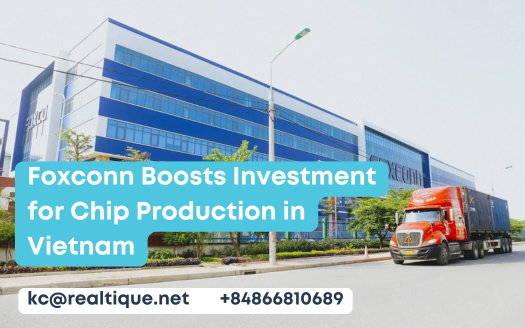Foxconn Boosts Investment for Chip Production in Vietnam
Foxconn’s recent commitment to invest 80 million USD through its subsidiary Shunsin Vietnam in Bac Giang marks a significant development in the semiconductor ecosystem. This strategic initiative aims to enhance chip production capabilities, with a focus on integrated circuits expected to meet rising global demand in key markets such as the US, EU, and Japan. As the project unfolds, it raises important questions about its implications for local economies, labor markets, and the broader global supply chain. What underlying factors are driving this investment, and how might they reshape the competitive forces of the semiconductor industry?
Table of Contents
Investment Overview
As Foxconn seeks to expand its global manufacturing footprint, its subsidiary Shunsin Vietnam has announced a substantial investment of 80 million USD in Bac Giang, emphasizing the company’s commitment to enhancing its production capabilities.
This significant financial commitment is directed towards the establishment of advanced chip production and assembly facilities in the region. The initial funding of 20 million USD will facilitate the project’s implementation, while the remaining 60 million USD will be raised through loans and capital mobilization efforts.
This investment represents approximately 75% of the total project capital, underscoring Foxconn’s strategic focus on semiconductor manufacturing. The initiative positions Shunsin Vietnam as a key player in the progressing environment of global electronics production, catering to increasing market demands.
Project Objectives
The investment in Bac Giang by Foxconn’s subsidiary, Shunsin Vietnam, is driven by specific project objectives aimed at revolutionizing semiconductor manufacturing in the region.
The primary focus is on the manufacturing and assembly of integrated circuits (ICs), essential components that include transistors and capacitors.
Shunsin Vietnam targets an impressive production capacity of 4.5 million ICs annually, with all products designated for export to key markets such as the United States, European Union, and Japan.
This strategic initiative aligns with the growing global demand for advanced semiconductor technology, positioning the facility as a critical player in the supply chain.
Ultimately, these objectives reflect Foxconn’s commitment to enhancing its capabilities and competitiveness within the semiconductor industry.
Timeline and Development
Planning for the Foxconn investment in Bac Giang unfolds with a clear timeline and structured development phases. The project is set to advance efficiently, with critical milestones outlined to guarantee timely completion.
| Phase | Timeline | Key Activities |
|---|---|---|
| Permit Acquisition | By December 2024 | Obtain construction permits |
| Construction Commencement | January 2024 | Start factory construction |
| Equipment Installation | By May 2026 | Install production machinery |
| Trial Operations | June 2026 | Begin initial testing of operations |
| Full Operation | By December 2026 | Achieve operational status |
This timeline emphasizes the project’s commitment to meeting the increasing global demand for semiconductor technology while adhering to a structured development approach.
Facility Specifications
With a substantial planned area of 44,343.8 m², the Foxconn facility in Quang Chau Industrial Park is designed to support advanced manufacturing capabilities.
The project is managed by the Saigon-Bac Giang Industrial Park Development Company, a subsidiary of Kinh Bac Urban Development Corporation, which specializes in industrial real estate.
This facility is expected to generate approximately 1,450 jobs, including 35 positions for foreign workers, contributing to the local economy.
Emphasizing efficiency, the facility will implement advanced automation technologies to streamline production processes.
The strategic design and technological enhancements aim to meet the projected annual production capacity of 4.5 million integrated circuits, ensuring competitiveness in the global semiconductor market.
Strategic Importance
As Foxconn continues to establish its presence in Vietnam, this investment highlights a strategic shift in the global manufacturing environment, moving production away from China.
The decision to invest heavily in chip production aligns with a broader trend among multinational corporations seeking to diversify their supply chains. By positioning itself in Vietnam, Foxconn aims to capitalize on the increasing demand for semiconductors, particularly from major markets such as the US, EU, and Japan.
This facility not only enhances Foxconn’s competitive edge but also reflects Vietnam’s growing significance as a manufacturing hub in Southeast Asia.
Additionally, the project is expected to create approximately 1,450 jobs, contributing positively to the local economy and promoting technological advancement in the region.





